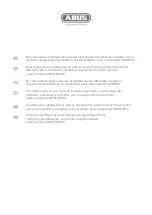
Voltage
Voltage
Voltage Loss
Loss
Loss Troubleshooting
Troubleshooting
Troubleshooting
Normal spraying voltage for a system is 45-55
kV. The system voltage is lower than the rated
voltage due to spraying current demands and normal
isolation system losses.
A loss of spraying voltage can be caused by a
problem with the spray gun, the fluid hose, or the
voltage isolation system, since all of the system
components are electrically connected through the
conductive, waterborne fluid.
Note
It is important to keep the inside of the
isolation cabinet clean. If the exterior of the
isolation fluid pump (K), the isolation valve
connecting rods (225), or plastic walls of the
cabinet (9) are dirty, voltage will be lost along
those paths.
1.
Check the isolation system for fluid leaks as
described in
Check for Fluid Leaks, page 67
.
2.
Check for connections between high voltage
components and grounded components
within the isolation system. The figure in
Troubleshooting HydroShield Voltage, page
76
identifies the high voltage, the isolation, and
the grounded components.
3.
Verify that the inlet air supply pressure is above
the minimum required 70 psi (0.5 MPa, 4.8 bar)
and the inlet air status bar is green. The air
inlet field appears on the Home screen. See
.
4.
Dispense enough fluid to expel any air pockets
from the fluid line.
5.
Verify that the electrostatic shield (12) is in place,
and then close and latch the cabinet door.
6.
Put the system in Spray mode. Enable
electrostatics by activating the ES request input
signal. Look at the Volt Level display on the
Home screen to see the spraying voltage. Under
normal conditions, the spraying voltage should
be between 45 and 55 kV. If the display shows 0
kV then continue with the next step. If the voltage
is above 0 but lower than expected, continue
with step 10.
7.
If the system is completely shorted out (0 kV)
the fault may be with the mechanical operation
of the isolation valve, grounding rod, or door
switch. Open the cabinet door and go to the
maintenance screens on the control interface.
• Activate the shuttle down and shuttle up valves
and verify that the shuttle travels up and down
smoothly. See
to activate the
shuttle.
• Activate the ground rod and make sure the
cylinder is retracting fully. (See
Misc Valve Resets and Test, page 61
.) If both
cylinders are working properly, then continue
with the next step.
Note
For the ground rod to activate, either
the cabinet door must be closed or
the door switch must be manually
switched.
8.
Verify that the door switch is working
properly. Follow the procedure in
Check the Door Switch, page 69
.
9.
If the kV is low, verify the accuracy of the kV
meter. Use a high voltage measurement probe
to measure the kV at the spray gun electrode.
The readings should be within a few kV. If they
are not, proceed to the next step.
10. Leakage internal to the isolation fluid pump could
also cause voltage loss. Check the pump weep
holes (WH) in the middle housing (307) for fluid
leaks. Service the pump if needed.
11. If voltage is still low, retest the gun and hose.
3A8493A
75
Содержание HydroShield WABL00
Страница 118: ...Parts Notes Notes Notes 118 3A8493A...
















































